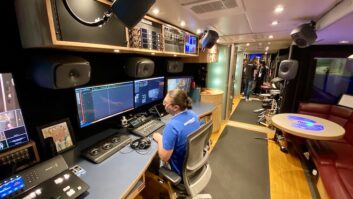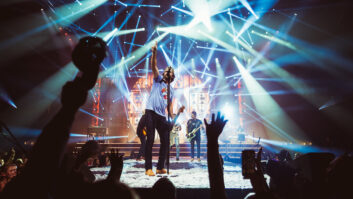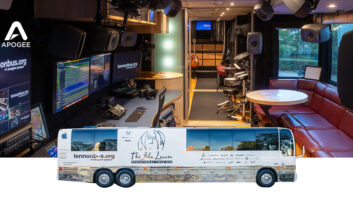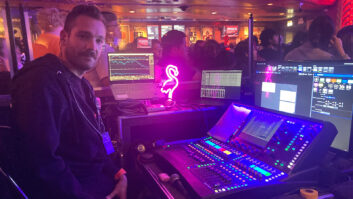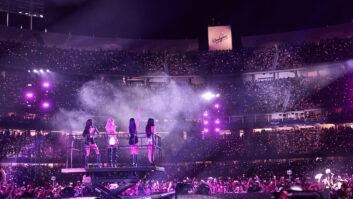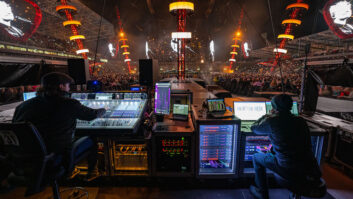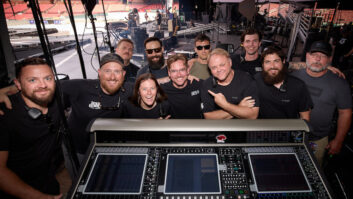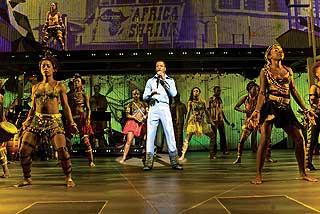
Fela!
” />
Kevin Mambo as Fela Kuti (center) and the Broadway cast of Fela!
Photo: Monique Carboni
New York City’s Eugene O’Neill Theatre got a blast of sub-Saharan heat this fall thanks to some wildly unlikely Broadway source material: the life of Nigerian musical firebrand Fela Anikulapo Kuti.
A controversial political and social figure, Kuti developed the Afrobeat sound in the ’70s and used his musical stature to rail against oppression in his homeland, only to be imprisoned and tortured by the military government. He was arrested 200-plus times and served an 18-month prison sentence that prompted international outrage from pop stars and politicians alike.
A notorious free spirit, Kuti also famously married two dozen of his backup singers and dancers (all at once) and proclaimed himself King of his own nation inside of Lagos, Nigeria. He died of complications of AIDS in 1997, at the age of 58.
After a successful off-Broadway run, Fela! opened on Broadway in November 2009 to rapturous reviews and sold-out audiences. Empowering the Afrobeat throughout the show is the sound design by Broadway newcomer Robert Kaplowitz. Kuti developed the groove-centric rock/reggae/R&B/jazz fusion sound of Afrobeat coincident with the emergence of sophisticated live sound systems, so Kaplowitz’s design entwines the story and music with a big concert sound. To meet those sonic needs, Fela! is heard through more than 80 house speakers, creating a powerful, loud soundscape and, more importantly, complex sonic imaging with full surround.
However, Fela! is still a Broadway musical and so contains strong aural contradictions, as Kaplowitz explains: “We’re focused on the oddly opposing goals of a big, loud Afrobeat sound and the serious imaging and intimacy demanded by Broadway storytelling needs. We had to decide, sonically, is Fela! a Broadway musical, a 1978 night at the Shrine [Fela’s Lagos club] or a 2009 Afrobeat concert? The answer is, ‘Yes!’ Fela! has to feel like Afrobeat while still being a musical. The sound must tell the story, so sometimes the music is loud, big, strong and powerful. But we also have to hear Fela’s quieter message. It is such an odd animal.”
And while Fela! is fairly loud for Broadway, it’s at an even level throughout the house. “We aren’t pushing 141 dB out of proscenium speakers,” Kaplowitz says. “We’re putting out solid levels—about 82 and 110 dB from every house speaker—so everyone gets a full, powerful experience.”
That’s partially due to restrictions on speaker placement dictated by the scenery. Kaplowitz was given no room around the proscenium for his main banks, but was told to hang his system from a large lighting/video projection grid high above the front orchestra seats. So traditional A/B, L/C/R and line array approaches were out. Instead, 13 speakers hang from the front-of-house grid (six EAW KF695s, three d&b Q7s, two d&b Q10s and two big d&b J-Subs).
Energetically loud and in-your-face sound is crucial to evoking Kuti’s milieu, but clarity is equally important. Key to achieving these two sides of the tonal spectra is the show’s separate speaker systems for vocals and the band, the Brooklyn-based Afrobeat flame-keepers Antibalas, an idea Kaplowitz credits to associate sound designer Jessica Paz. They are using big rock ’n’ roll–style tri-amped KF695s for the band and modern vocal-centric d&b Q7s for vocals.
“We asked, ‘What does separating the band and vocal speakers buy us?’ More clarity in the vocals without turning the band down,” he continues. “I really like the d&b Q7s for vocals: They’re clean and transparent and cover the areas they’re designed to cover and not much more. I’ve also always liked the KFs. So when Jessica suggested we separate band and vocals, I knew the KFs were good at putting out complicated music, which this is. The KFs have got a real fullness and reproduce powerful instruments well.”

Sound designer Robert Kaplowitz outside of Broadway’s Eugene O’Neill Theatre
Photo: Eric Rudolph
The two alternating actors playing Kuti (Sahr Ngaujah and Kevin Mambo) often switch between a cardioid handheld mic (used in proximity-effect mode) and a head-worn boom unit. The dramatic difference between the sound of the large-diaphragm handheld Sennheiser SKM 5200 (with Neumann KK104S capsule) and the head-worn mic could have been jarring for the audience, so this was a big issue to address. “The handheld is a 1.9-inch cardioid capsule and the head mic is an 1/8-inch omni,” Kaplowitz notes, emphasizing their wildly different characteristics. Worse still, the head-worn mic is a short boom that places the capsule cheek-side, not in front of the singer’s mouth. Fortunately, the first switch from hand mic to headworn is separated by a musical interlude. “Bill T. Jones [Fela! co-creator/director/choreographer] gave me that interlude during ‘Yellow Fever,’ which has a big sax solo. So people can forget a little bit about the sonic difference.”
The lavs on most performers are Sennheiser MKE-1s, chosen for their brightness and clarity, as well as their “intense ability to withstand sweat.” “Fela” wears a double rig of one MKE-1 (primary) and one Countryman B3 (backup) in a head rig handmade by the deck sound team.
Another ingredient to this sound design is marrying the wildly dramatic movements of the dancers with the tonality of the music. Kaplowitz says they had to “sonically embody the physicality and freewheeling movement of the cast, so we created a complex delay matrix to align—in time, space and volume—all 80 speakers to 13 different individual locations on the stage and in the house, and to two floating zones for the vocals. This creates precise sonic imaging, allowing the audience to close their eyes and still know where each singer is standing.
“We sought an all-encompassing, ‘We’re in the club, there are no boundaries between audience and performers’ sound. The best way to pull the audience into the action was to place them in the middle of it. Nearly everyone in the audience is in the field of full surround: front, side, rear and subwoofers.”
The sonic imaging also effectively sells the conceit that the actors playing Kuti are actually performing his Coltrane-influenced tenor-sax solos, Kaplowitz acknowledges.
But the free use of the entire orchestra level and boxes by the company—they wildly dance through the aisles, box seats and on a long runway at stage right—creates issues in a house filled with 80 speakers set up for surround. Several mix-minus zones were added to allow the lav mics to be right in front of vocals-only speakers. “The speakers in mix-minus zones will either be off or down 12 dB,” Kaplowitz explains.
They tried to make in-ear monitoring work, but “the actors struggled with being somewhat sonically isolated from the audience,” Kaplowitz says. “The men playing Fela really wanted to not only hear the audience comments, but to localize them and respond.”
Instead, the show relies on a full onstage monitor system comprising 15 speakers and a dedicated monitor mixer and console. (As the wings were packed, the monitor desk—a Yamaha M7CL-48 with 48 inputs and 24 outputs, all in use—is located in the basement.) “We’ve put monitors everywhere: Two are set into the deck downstage, a set lines the underside of the runway, one is upstage-left under the catwalk and a few [are] in the wings,” Kaplowitz explains. “Using a lot of focused speakers, no single box has to be blaring; we’re not asking for wedges to cover 30 feet.” Monitors include four L-Acoustics 108Ps and eight MTD 108s (powered and unpowered versions of the same wedges), as well as three EAW MicroWedges.
Front-of-house console is a Yamaha PM1DV2, using 92 inputs and 66 outputs, and redundant DSP1D digital audio mixing systems. The three digital mixing engines are at full capacity thanks to the effects, surround and sonic imaging. Four Summit DCL 200 tube compressors add vintage ’70s warmth to the lead vocals and the band’s four horns.
Kaplowitz is living with an odd assemblage of gear due to budgetary issues, noting the FOH board is old enough that it uses SCSI cables. “We have an odd mixed system, but it all works and is reliable,” he notes. “I’m really happy with the results. We responded to Bill T. Jones’ vision from beginning to end, and made a piece of art that’s wildly entertaining. I think that’s in sync with Fela’s spirit.”
Eric Rudolph—a New York City–based writer and lifelong audio aficionado—saw Fela Kuti perform in New York in the mid-’80s.

